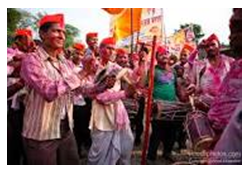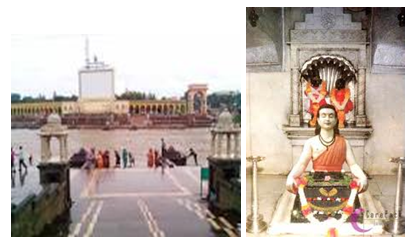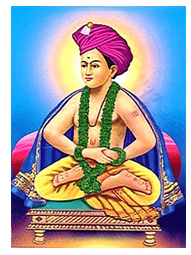SANT JNANESHWAR (OR DNYANESHWAR)
Contents
. Introduction
. His Forefathers
. Birth and Early Life
. The Miracle at Nevasa
. Other Miracles
. Jnaneshwari or Bhavartha Deepika
. Other Works
. Translation
. Varkari Movement
. Samadhi
. Conclusion
Introduction
 One of the greatest poet saints and philosophers of India was Sant Jnaneshwar who was born in Maharashtra in the 13th century. During this period there was not much knowledge of Sanskrit in Maharashtra and only a miniscule percentage of society followed it. The majority of the people were thus denied the wealth of ancient Hindu scriptures and religious knowledge. Jnaneshwar rose as a very bright star on the horizon of Scriptural knowledge as he was bold enough to go against the strict norms set up by the Brahmins by using the local language Marathi as his vehicle for preaching. His life story is mainly written from legends as only a few parts of his life have been actually recorded by Satchidanand Baba in his book Jnaneshwar Vijay and have been found in the Abhangs composed by another famous Marathi saint Namdeo.
One of the greatest poet saints and philosophers of India was Sant Jnaneshwar who was born in Maharashtra in the 13th century. During this period there was not much knowledge of Sanskrit in Maharashtra and only a miniscule percentage of society followed it. The majority of the people were thus denied the wealth of ancient Hindu scriptures and religious knowledge. Jnaneshwar rose as a very bright star on the horizon of Scriptural knowledge as he was bold enough to go against the strict norms set up by the Brahmins by using the local language Marathi as his vehicle for preaching. His life story is mainly written from legends as only a few parts of his life have been actually recorded by Satchidanand Baba in his book Jnaneshwar Vijay and have been found in the Abhangs composed by another famous Marathi saint Namdeo.
His Forefathers
Eight miles on the East side of Paithan on the north bank of the Godavari river there was a village named Apegaon. Trimbakpant, the great grandfather of Jnaneshwar, lived in this village. When one of his sons Haripant was killed in the battlefield, Trimbakpant lost all interest in worldly affairs and wished to dedicate his life to God. At this time Gorakhnath, the great ascetic of the Nath tradition visited Apegaon and initiated Trimbakpant as his disciple. Trimbakpant had another son Govindpant who was married and who subsequently had a son named Vithalpant. At the age of seven, Vithalpant was initiated into the thread ceremony. He was soon well versed in the study of the Shastras and Vedas and having a religious bent of mind, taking his father’s permission he went on a pilgrimage to holy places like Dwarka, Bhimashankar, Trimbakeshwar etc and finally came to Alandi around 30 kms from Pune. A local Yajurveda Brahmin came into contact with him and became highly impressed by his simplicity and demeanour. He offered him his daughter Rukmini in marriage and Vithalpant agreed as Rukmini was a pious and noble woman. He then went with his wife and inlaws to Apegaon where he served his parents till their death. He then returned to Alandi and continued his life there. Vithalpant having a spiritual bent of mind did not have much interest in worldly affairs and would often ask his wife to allow him to go to Kashi to become a Sanyasi, but she would always refuse him. One day without asking permission he left for Kashi and became a disciple of Swami Ramanand as he lied to him by telling him that he was all alone in the world. Meanwhile, news of his accepting sanyas reached Rukmini but she had great faith in God and refused to get disheartened. She continued her worship of God for twelve years. One day Swami Ramanand on a pilgrimage came to the temple where she performed her daily worship and blessed her that she may get a son. At this Rukmini could not help smiling and when Swami Ramanand asked her the reason she told him about her husband leaving home. Swami Ramanand divined that Vithalpant was her husband and immediately left for Kashi taking her and her father with him. After reaching Kashi he reprimanded Vithalpant and asked him to return to Alandi and embrace Grihastashram or householdership. Forced to obey the orders of his Guru Vithalpant returned to Alandi.
Birth and Early life
In the course of time Vithalpant had four children, three sons born in 1273, 1275, 1277 respectively and a daughter born in 1279. Being highly spiritual he named his children Nivritti, Jnanadev, Sopan and Muktabai implying that when one is released from worldly bondage (Nivritti) and finds real knowledge (Jnana) he secures the bridge (Sopan) which leads him to liberation or Mukti (Muktabai). These were the steps to Moksha or salvation. Their eldest son Nivrittinath was initiated into the Nath tradition by Gahininath at the age of ten when they were all on a pilgrimage to Trimbakeshwar near Nashik. When it was time to perform the thread ceremony of the sons, none of the Brahmins in the village agreed to perform it as it was against the Shastras to return to a householder’s life after accepting Sanyas. When Vithalpant pleaded with the orthodox Brahmins on a way to atone for the sin they consulted all the religious books and suggested that he and his wife should give up their lives by jumping into the holy waters of the Ganga and the Yamuna at Prayag. Accordingly Vithalpant obeyed them leaving the young children destitute at a very young age. Not knowing what to do the four young children went to Apegaon but none of their relatives helped them, so they returned to Alandi. It was a heart rending sight as the eldest son Nivritti was said to be only ten years old around that time. Finally, Jnaneshwar advised Nivritti that they would all go to Paithan to get a certificate of purity from the learned Brahmins of Paithan. This has been mentioned by Mahipathi, the 18th century biographer of Bhakti poets and saints. Facing many dangers and fighting many difficulties eventually they all reached Paithan. When the Brahmins scorned them Jnaneshwar said that the same God was present in all beings and was said to have proved it by placing his hand on the head of a buffalo who then began reciting the Vedas to the astonishment of the learned Brahmins. The Brahmins witnessed this great miracle and had to accept the supernatural powers and greatness of Jnaneshwar. They granted them the certificate of purity but never performed their thread ceremonies. All the other three siblings became students of their eldest brother Nivrittinath when Jnaneshwar was eight years old and he mastered the scriptures and various aspects of Kundalini yoga.
The Miracle at Nevasa
Soon they moved to Nevasa a village in Ahmednagar district. Legends say that one day they found a lady weeping bitterly near the dead body of her husband. On being informed that the name of the dead person was Satchidananda, Jnaneshwar said that a person with such a profound name could never be lifeless. Touching the lifeless form he immediately brought him back to life. It was this person who later on wrote the Jnaneshwar Vijay and became the scribe of Jnaneshwar when he wrote the Jnaneshwari.
Other Miracles
There were many miracles performed by Jnaneshwar. Once a Brahmin wished to perform the Shraadh ceremony of his father. Jnaneshwar then requested all his forefathers to partake of the feast. Normally ancestors are said to come, but they are not visible. However in this case they were said to be physically present and enjoyed the feast.
 Once in Alandi there was an orthodox Brahmin named Visoba Chati who used to ridicule sages and sadhus. Once Muktabai wished to bake a dish on a frying pan. But on the instigation of Visoba none of the potters in the village agreed to sell her a pan. Sobbing she returned home but Jnaneshwar kindled the fire inside his stomach by the power of yoga and asked her to bake the dish on his back which was red hot as a frying pan.
Once in Alandi there was an orthodox Brahmin named Visoba Chati who used to ridicule sages and sadhus. Once Muktabai wished to bake a dish on a frying pan. But on the instigation of Visoba none of the potters in the village agreed to sell her a pan. Sobbing she returned home but Jnaneshwar kindled the fire inside his stomach by the power of yoga and asked her to bake the dish on his back which was red hot as a frying pan.
Another instance is of a great Yogi named Changdeo who rode a tiger and used a serpent as a whip having complete control on animate beings. He wished to visit Jnaneshwar and came riding on his tiger. At that time Jnaneshwar and his brothers and sister were sitting on a compound wall. When they saw him approaching them the wall itself began to move to receive him. Stunned Changdeo realised that Jnaneshwar had complete control even on inanimate objects and realised his greatness overcoming his own ego and pride, fell at his feet and became his disciple.
Jnaneshwari or Bhavartha Deepika (meaning the light reflecting the inner meaning of the Gita)
Nivruttinath instructed Jnaneshwar to write a commentary on the Bhagavad Gita in Marathi. Jnaneshwar composed the 18 chapters in a metre called ’Ovi’ and brought the Bhagavad Gita to the common man who could not understand Sanskrit. It is said that Jnaneshwar was only sixteen years old when he composed it. The language and the poetry used was captivating and is considered the basic book of the Varkari sect. The 700 shlokas of the Gita were dealt with in 9000 Ovis. The Pasayadan or the last nine verses of the Jnaneshwari are most popular of them all. The Jnaneshwari gives a detailed analysis of metaphysics, astrology and yoga. It is widely studied in most households in Maharashtra and has been greatly revered by all other saints like Eknath, Tukaram and Namdeo.
Other Works
Jnaneshwar wrote the Amritanubhava which is a beautiful book of his own experiences of Yoga and philosophy. Besides this he wrote Changdeva Pasashti, Haripath and composed many Abhangs.
Translation of a shloka of the Pasayadan
“May the evil minded their wickedness shed
May their intellect turn towards pious and good deeds
May all living beings find themselves bonded
By friendly ties of Soul Companionship”.
Varkari Movement
 Jnaneshwar is said to have laid the foundation of the Bhakti movement in Maharashtra which was later on taken to its peak by Tukaram and other saints. He strongly advocated devotion with knowledge (Jnanayukta Bhakti) and introduced the Varkari Sampradaya of singing and praying to Lord Vithala of Pandharpur while taking a pilgrimage. Even to this day Varkaris on foot place the Padukas of Jnaneshwar in a palanquin (Palki) and travel by foot from Alandi to Pandharpur in the holy month of Ashadh of the Hindu calendar.
Jnaneshwar is said to have laid the foundation of the Bhakti movement in Maharashtra which was later on taken to its peak by Tukaram and other saints. He strongly advocated devotion with knowledge (Jnanayukta Bhakti) and introduced the Varkari Sampradaya of singing and praying to Lord Vithala of Pandharpur while taking a pilgrimage. Even to this day Varkaris on foot place the Padukas of Jnaneshwar in a palanquin (Palki) and travel by foot from Alandi to Pandharpur in the holy month of Ashadh of the Hindu calendar.
Samadhi
Jnaneshwar completed his works and is then said to have gone on pilgrimage with Namdeo and other saints. He then expressed to the others that he wished to attain Samadhi and at the tender age of 21 in the year 1296 on the 13th day of the second half of the month of Kartik he attained Nirvikalpa Samadhi at Alandi near Pune in Maharashtra. Namdeo wrote on this incident in his set of Abhangs named Samadhheche Abhanga. It is said that within two years his brothers and sister who were also highly spiritually evolved souls too left the material world.
Samadhi at Alandi

Conclusion

Sant Jnaneshwar was one of the greatest saints of India whose followers belonged to all castes as he believed that God was beyond rituals and casteism and could be propitiated only through deep and abiding love and devotion. He inspired other saints like Namdeo the tailor’s son, Gora Kumbhar the potter, Narahari the goldsmith, Janabhai the maid servant etc and his works charged all the people with wisdom and devotion. His beautiful and elevating words still inspire millions to this day to follow the Godward path and transcend the cycles of birth and death to achieve truth, bliss and salvation.
